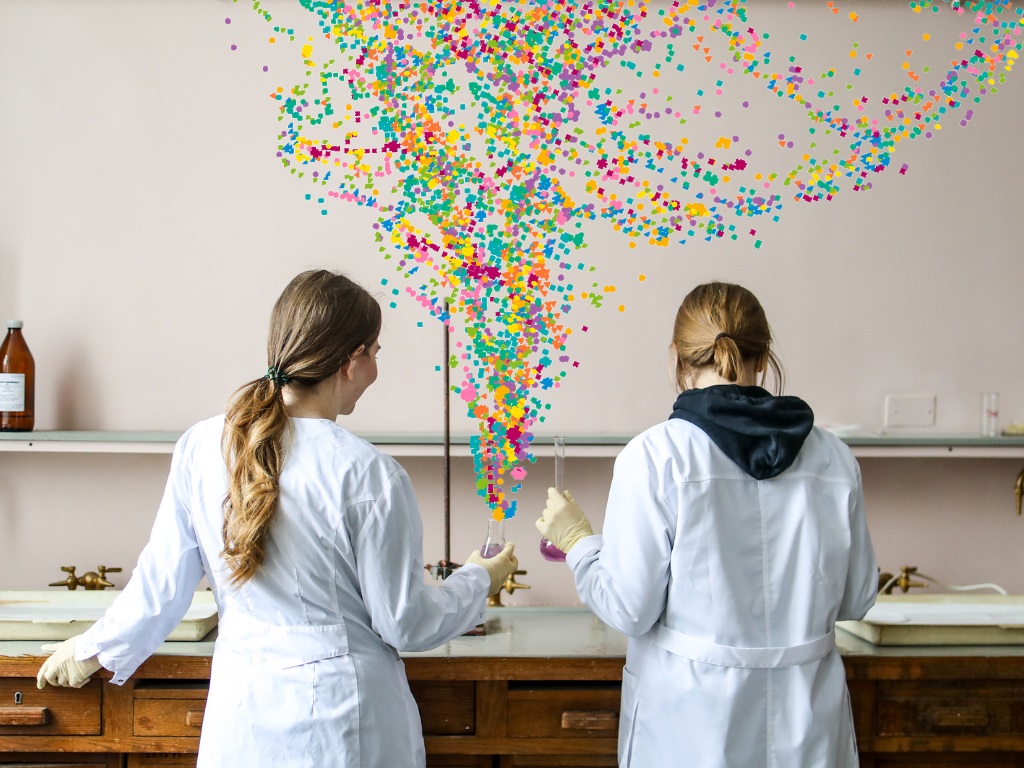By Stacey Wheeler, Senior Science Technician
When students come to us from year 6 they are amazed to be in a real lab; the benches, the high stools, sinks, gas taps, and all the sockets around!
For some the novelty wears off quicker than others. Perhaps they realise that the stools aren’t actually that comfortable. Or, and I can’t believe I’m saying this but it could be down to a lack of interest in science. Whatever the reasons, this is where our science teachers come in. The people who inspire the next generation of scientists. It is our job to engage students and get them interested in something that is all around us. And what is one of the key tools to help us do this? A science practical. And more importantly, getting the practical done correctly so they get the results to prove a theory!
When students come to us we want to bring excitement, let them use the equipment as much as possible, without taking away from the learning.
Rainbow fizz
Those two words say it all really, do I have to explain further? This one throws probably the first colour change students will see right in front of their eyes into the mix. Incorporating steady skills and a challenge of who can produce the best pH range makes for a great experiment. Another bonus is that it’s cheap to do, consisting of only 4 chemicals and a few other pieces of equipment. I know I don’t have to tell you how special a pipette is to precise measurements!
- Using the standard hydrochloric acid and sodium hydroxide solutions we pour around 20ml of acid into a boiling tube
- Add a spatula of sodium carbonate then a couple of drops of universal indicator.
- Now comes the precise part, slowly and sparingly, sodium hydroxide is dripped down the side of the boiling tube.
Technique is key, and there are many varying results. But great fun all round.
Rock salt experiment
- We start by crushing the rock salt with a pestle and mortar, then we mix with water using a measuring cylinder, beaker and stirrer.
- Next comes filtering using a conical flask, filter paper and funnel to get rid of the sand in the mixture.
- And finally pouring our solution into an evaporating basin.
- At this point you can either heat using a Bunsen burner or it can be left to evaporate naturally over a few days.
This is great experiment to show that not everything dissolves in water and that we can use the process of evaporation to separate substances. This is a very top heavy experiment for equipment but overall is not that messy! We can go into more depth with older students and do a specific weight of the rock salt and find out how much salt is produced at the end.
Circuits
Wires all over the place! This experiment teaches students the basics of electrical circuits. What can conduct, what doesn’t? Is there a better material? How does your light switch work? What goes into the workings of the school bell (if you still use the old school electrics of course).
How can you work safely with electric. It is a great experiment and one that is relatively safe. Learning about things like this and being able to see it work right in-front of you is a great thing. Sometimes there is even time to get a solar panel out or design a wind turbine and see the production of power from these. Students really do thrive of being given some independence to lead their practical and find out what does and doesn’t work.
Burning foods
You read that and thought bunsen didn’t you? Surprisingly not on this occasion! When we teach about burning foods, we find that a tea light is a lot safer to use to get the food alight. For this experiment students are given a range of crisps, crackers and poppadums/ prawn crackers.
They light the piece of food and see what temperature the water gets to in their boiling tube from that piece of food. We can make this more complicated by using the same weight of the different food to make it a fair test. We make sure the same amount of water is being used by measuring it with a measuring cylinder. No prizes for guessing the most energy packed food!
Air resistance- parachute demo
Let’s face it, if you get out a parachute and challenge the students to run so far in a certain amount of time, a lot of them will jump at the chance, and if they don’t, you still know that you will have their full attention on what is going on! So we use 2 different sizes of parachute and compare our results as a class. Seeing these things in the now really does help.
These can be equipment and chemical heavy but they prove exactly what we want them to see, understand and learn. What practicals would you add to this list? Which ones do you think bring the necessary awe and wonder? And have any failed spectacularly?
Oxford Smart Activate is a complete Key Stage 3 science curriculum: informed by research and you. With Oxford Smart Activate, you are fully supported to deliver a Key Stage 3 science experience that connects to your students lived experiences. One that nurtures students, builds skills and knowledge, and carries that curiosity through to GCSE.
Further reading:
- ‘Lab Equipment that spark awe and wonder in classroom‘ by Stacey Wheeler
- ‘Using Oxford Smart Activate’ by Adele Read
- ‘Developing metacognition through the science curriculum’ by Dr Andrew Chandler-Grevatt



